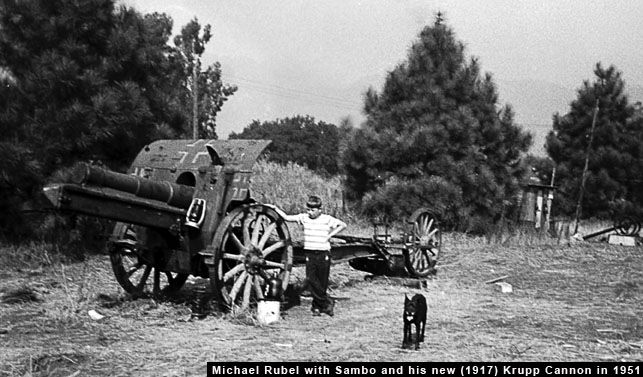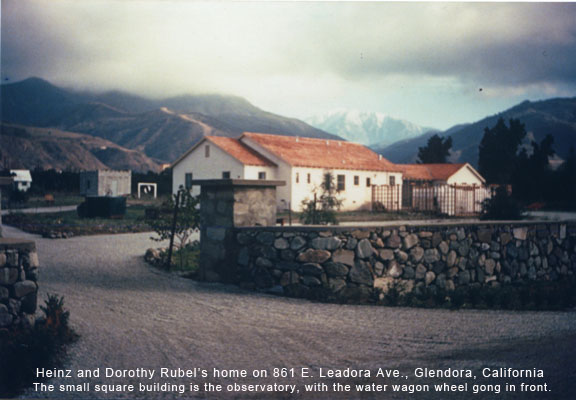Michael Rubel's 1917 German Krupp Cannon
—Michael C. Rubel, 1/25/1989

As children many of us played war with the Krupp cannon on the WWII scrap pile located on the Dalton Wash just north of Leadora Avenue. The great pile of metal that had been donated for the war effort was priceless for children, but the incredible toy was this cannon. We painted it and oiled it and greased it and protected it.
The time came when a bunch of us wanted to move the cannon to our fort located across the Dalton Wash. Mr. Ole Hammer explained that the American Legion owned the cannon and we would have to get their permission to have it. This was about 1949. We went to, what seemed like, countless people to argue for possession of this cannon. We, after all, were responsible for painting it with donations from Jim Reed, who gave paint with the condition we painted it brown. Jim Reed had a lot of old brown paint, we discovered.
At one point we removed a wheel to grease the hub and the cannon fell down on one side making it impossible to move. One morning we found the wheel had been replaced. We all thought this was an act of God.
When I was eleven years old my friends pushed me to get the cannon. We assembled at the American Legion Hall on Cullen Avenue for this momentous occasion. I was frightened to death. Yelling at everyone in the hall I explained it was our cannon; we made it better with grease; made it shiny with paint and no one had more right to this cannon than David Wilson, Duncan Menser, Skipper Landon, or Me. A great applause gave way to a motion that I be sold this cannon for a dollar, with a condition that we move it within three days. The Legionnaires thought this would be the end to the issue since children could not possibly move an eight ton cannon. When we begged Lorne Ward to help us, he said he could not for the Legion really wanted to keep it for their hall on Cullen Avenue. Carl Gunn and Frank Brown gave us similar answers. On the third day, in total despair, I went to Wilson School knowing we had lost the cannon.
Getting home
that afternoon I found the cannon right in front of our fort.
Again, a miracle which made me very heady
with my magical
powers.
Many years later I found that Fred Barns and Carl Woford and Andy
Blair had moved it, probably with Ole Hammer’s blessing,
to get it off the irrigating company property.
Frank Teeter gave me a dollar for greasing the Pacific Electric
Tracks (this made the Red Car slide into Recreation Park surprising
everyone
on board) and the bill of sale was issued and notarized.
In 1954 Odo and Maria Stade convinced me that the cannon would attract a bombing should the Russians fly over Glendora and spot the cannon. This is the kind of logic I have always suffered with. It shows.
I was offered five hundred dollars by the Los Angeles Historical Museum, but not knowing what five hundred dollars meant, I turned them down. When they offered me a brand new Winchester shot gun (which cost about $50) to win the Glendora Turkey Shoot with on the Charley Gordon Ranch, I jumped at the offer. I still have the shot gun, but did not win a turkey.
From Christopher S. Rubel (Mykee's Brother)
7/29/09
Looking at the photo above, I noticed the wagon wheel at the plow end of the Howitzer. I think that wheel is the remainder of the old Glendora water wagon chassis we had at the north end of 861 East Leadora. It was a Studebaker water wagon (no tank on the chassis when we got the property) and the whole thing, (chassis, wheels, buck seat, and the tongue) was together when Heinz bought the property. Eventually, the wheels fell apart and we used one of the iron rims for a gong, hanging one on a sturdy frame just south of the observatory building. One could hear that gong from a long ways off. It was impressive and was used to get us to come for dinner, etc.
Michael's first towers were built from the wood I had collected (or at least some of the wood was used for his towers) to make my underground tunnels just north of the observatory, where the Stades eventually built. I had tunnels covered with wood and dirt so the Japanese could not see them from the air. Once, when going through my tunnel, I was confronted by a snake. The black widows didn't terrify me, but that snake ended my sense of security in my tunnels. I suppose my deteriorating spine is a remnant of all the digging I did where Mike eventually built his towers.
I wonder when Mike turned the howitzer so it faced east. He used to "fire" the rocks east over, or into, the Veach's grove. He used carbide for a propellent. What memories! Daddy
PS: A few years ago, the town of Fillmore had a matching howitzer at a site on Highway 126. I thought at first it might be the same one, but it was enough different that I realized it was just another one. Michael's worked somewhat. The wheel could control the elevation of the barrel to some extent. He may have gotten other parts of it to work, too.

TOP
OF PAGE
| HOME to the SHRIEK Links
What
Is The Pharm, by Ed Keith
| Artsy Photos
The Fox | The
ROMEOs | Redd
Ryder
| The
Gate
SEE
MORE GREAT PICTURES AND STORIES HERE |
Rubel Pharm dot org
Now Famous in China